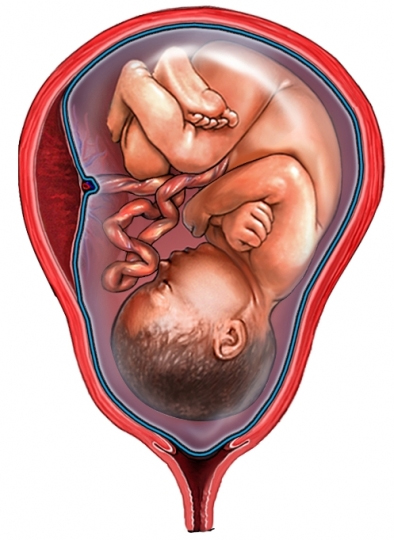

DEFINITION: Spontaneous rupture of the membranes any time beyond 28th week of pregnancy but before the onset of labor is called prelabor rupture of the membranes (PROM). When rupture of membranes occurs beyond 37th week but before the onset of labor, it is called term PROM and when it occurs before 37 completed weeks, it is called preterm PROM. Rupture of membranes for > 24 hours before delivery is called prolonged rupture of membranes.
INCIDENCE: PROM occurs in approximately 10% of all pregnancies.
CAUSES: In majority, the causes are not known. The possible causes are:
1) Increased friability of the membranes
2) Decreased tensile strength of the membranes.
3) Polyhydramnios
4) Cervical incompetence
5) Multiple pregnancy
6) Infection - Chorioamnionitis, urinary tract infection and lower genital tract infection
7) Cervical length < 2.5 cm
8) Prior Preterm Labor
9) Low BMI (< 19 kg/m2).
DIAGNOSIS: The only subjective symptom is escape of watery discharge per vaginum either in the form of a gush or slow leak. This is often confused with:
CONFIRMATION OF DIAGNOSIS:
1) Speculum examination is done taking aseptic precautions to inspect the liquor escaping out through the cervix
2) To examine the collected fluid from the posterior fornix (vaginal pool) for:
3) AmniSure—A rapid immunoassay is accurate
4) Ultrasonography is to be done not only to support the diagnosis but also to assess the fetal well being. Digital vaginal examination should be avoided.
INVESTIGATIONS:
1) Full blood count
2) C-reactive protein (CRP)
3) Urine for routine analysis and culture
4) High vaginal swab for culture (specially for Gr. B Streptococcus)
5) Vaginal pool for estimation of phosphatidyl glycerol and L: S ratio
6) Ultrasonography for fetal biophysical profile and
7) Cardiotocography for nonstress test
DANGERS: The implications are less serious when the rupture occurs near term than earlier in pregnancy.
1) In term PROM labor starts in 80–90% of cases within 24 hours. PROM is one of the important causes of preterm
labor and prematurity
2) Chance of ascending infection is more if labor fails to start within 24 hours. Liquor gets infected (chorioamnionitis) and fetal infection supervenes
3) Cord prolapse, especially when associated with malpresentation
4) Continuous escape of liquor for long duration may lead to dry labor
5) Placental abruption
6) Fetal pulmonary hypoplasia, especially in preterm PROM is a real threat when associated with oligohydramnios
7) Neonatal sepsis, RDS, IVH and NEC in preterm PROM
8) Perinatal morbidities (cerebral palsy) are high.
Maternal complications of PROM: Chorioamnionitis, placental abruption, retained placenta, endometritis, maternal sepsis and even death.
HOMOEOPATHIC MEDICINES FOR MANAGING PROM:-
1) Cal phos:- this remedy can help to strengthen a woman who tends toward easy tiredness,poor digestion, cold hands and feet, and poor absorption of nutrients. A person who needs cal phos is often irritable because of tiredness, and may long for a travel or a change of circumstances.
2) Caulophyllum:- this remedy may be helpful in women with weak muscle tone in the uterus. A history of irregular periods, slow and difficult labour with previous deliveries, or weakness of the cervix may bring this remedy to mind. She typically feels nervous, shaky, and trembling.
3) Carbo Veg:- this remedy can be helpful to a woman who feels weak and faints during pregnancy, with poor circulation, a general feeling of coldness, and a craving for fresh or moving air. She may also have frequent digestive upsets with burning pain and a tendency to belch.
4) Actaea racemosa:- this remedy can be helpful to women who are nervous and talkative,with a tendency to feel fearful and gloomy during pregnancy. They may become overagitated and a dear of miscarriage prevails.
5) Ferrum phos:- this remedy can be helpful for nervous sensitive women who feel weak or tired with easy flushing of face and a tendency towards anaemia. A woman who needs this remedy often has a slender build and may develop frequent neck and shoulder stiffness.